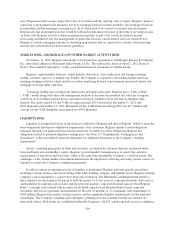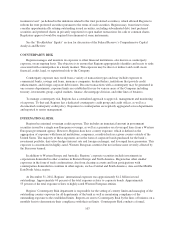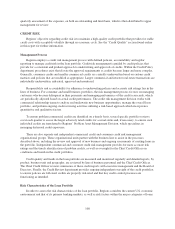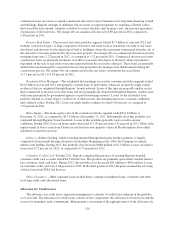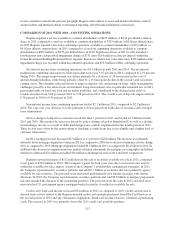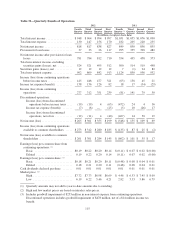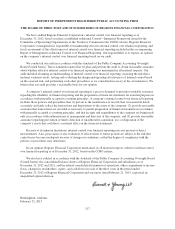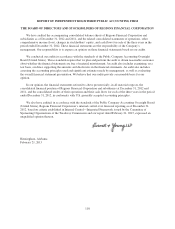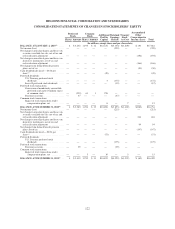Regions Bank 2012 Annual Report Download - page 128
Download and view the complete annual report
Please find page 128 of the 2012 Regions Bank annual report below. You can navigate through the pages in the report by either clicking on the pages listed below, or by using the keyword search tool below to find specific information within the annual report.Management considers the current level of allowance for credit losses appropriate to absorb losses inherent in the
loan portfolio and unfunded commitments. Management’s determination of the appropriateness of the allowance for
credit losses, which is based on the factors and risk identification procedures previously discussed, requires the use of
judgments and estimations that may change in the future. Changes in the factors used by management to determine the
appropriateness of the allowance or the availability of new information could cause the allowance for credit losses to
be increased or decreased in future periods. Management expects the allowance for credit losses to total loans ratio to
vary over time due to changes in portfolio balances, economic conditions, loan mix and collateral values, or variations
in other factors that may affect inherent losses. In addition, bank regulatory agencies, as part of their examination
process, may require changes in the level of the allowance based on their judgments and estimates.
Additional discussion of the methodology used to calculate the allowance for credit losses is included in
Note 1 “Summary of Significant Accounting Policies” and Note 6 “Allowance for Credit Losses” to the
consolidated financial statements. Details regarding the allowance for credit losses, including an analysis of
activity from the previous year’s total, are included in Table 17 “Allowance for Credit Losses.” Also, refer to
Table 18 “Allocation of the Allowance for Loan Losses” for details pertaining to management’s allocation of the
allowance for loan losses to each loan category.
FINANCIAL DISCLOSURE AND INTERNAL CONTROLS
Regions has always maintained internal controls over financial reporting, which generally include those
controls relating to the preparation of the consolidated financial statements in conformity with accounting
principles generally accepted in the U.S. Regions’ process for evaluating internal controls over financial
reporting starts with understanding the risks facing each of its functions and areas, how those risks are controlled
or mitigated, and how management monitors those controls to ensure that they are in place and effective. These
risks, control procedures and monitoring tools are documented in a standard format. This format not only
documents the internal control structures over all significant accounts, but also places responsibility on
management for establishing feedback mechanisms to ensure that controls are effective.
Regions has also established processes to ensure appropriate disclosure controls and procedures are
maintained. These controls and procedures as defined by the Securities and Exchange Commission (“SEC”) are
generally designed to ensure that financial and non-financial information required to be disclosed in reports filed
with the SEC is reported within the time periods specified in the SEC’s rules and forms, and that such
information is communicated to management, including the Chief Executive Officer (“CEO”) and Chief
Financial Officer (“CFO”), as appropriate, to allow timely decisions regarding required disclosure.
Regions’ Disclosure Review Committee, which includes representatives from the legal, risk management,
accounting, investor relations, treasury and audit departments, meets quarterly to review recent internal and
external events to determine whether all appropriate disclosures have been made in reports filed with the SEC. In
addition, the CEO and CFO meet quarterly with the SEC Filings Review Committee, which includes senior
representatives from accounting, legal, risk management, audit, treasury, the lines of business, and
administration. The SEC Filings Review Committee reviews certain reports to be filed with the SEC, including
Forms 10-K and 10-Q and evaluates the adequacy and accuracy of the disclosures. As part of this process,
certifications of internal control effectiveness are obtained from accounting, treasury, legal, audit, risk
management, the lines of business and administration. These certifications are reviewed and presented to the
CEO and CFO as support of the Company’s assessment of internal controls over financial reporting. The Form
10-K is presented to the Audit Committee of the Board of Directors for approval, and the Forms 10-Q are
reviewed by the Audit Committee. Financial results and other financial information are also reviewed with the
Audit Committee on a quarterly basis.
As required by applicable regulatory pronouncements, the CEO and the CFO review and make various
certifications regarding the accuracy of Regions’ periodic public reports filed with the SEC, as well as the effectiveness
of disclosure controls and procedures and internal controls over financial reporting. With the assistance of the financial
112




